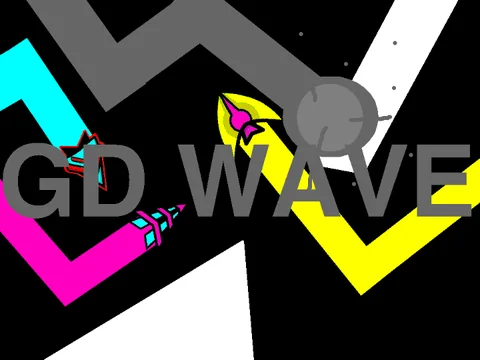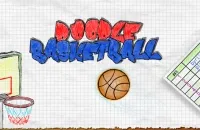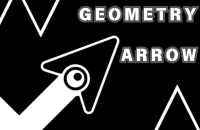Geometry Dash Wave
Geometry Dash Wave
Connecting to game server...
0% complete

Geometry Dash Wave
Click to start playing
🕹️ You May Also Like












Geometry Dash Wave
Master the challenging wave game mode with smooth, flowing movements through narrow passages. Focus on precise control and rhythm synchronization.
Geometry Dash Wave focuses on the challenging wave game mode, where smooth, flowing movements are key to success. Control your character as it moves in wave-like patterns through narrow passages and tight spaces. This version emphasizes the wave mechanics with levels specifically designed to test your ability to maintain smooth, controlled movement while following the rhythm of the music.
🎮 How to Play
- 1Hold to move up, release to move down
- 2Smooth movements are key
- 3R to restart level
💡 Game Tips
- 💡Wave mode requires smooth, controlled movements
- 💡Don't make jerky motions - flow with the music
- 💡Practice maintaining steady rhythm
- 💡Focus on the path ahead, not just current position
📚Complete Strategy Guide
Master Geometry Dash Wave with our comprehensive guide and pro tips
Basic Strategy
Geometry Dash Wave focuses entirely on the challenging wave game mode, where smooth, flowing movements are the key to success. Unlike traditional cube jumping, wave mode requires continuous control input, making it one of the most technically demanding game modes in the Geometry Dash series. This specialized version allows players to master wave mechanics through levels specifically designed to test smooth, controlled movement.
Wave Mode Fundamentals: The wave moves continuously through the level, requiring constant input adjustments rather than discrete jumps. Your character follows a sine-wave pattern that you control by holding and releasing the input button. This creates a unique challenge where precision and smooth control are more important than quick reflexes.
Continuous Input Management: Unlike cube mode where you jump at specific moments, wave mode demands sustained attention and micro-adjustments throughout the entire level. The slightest input variation affects your trajectory, making consistency and muscle memory crucial for success.
Narrow Passage Navigation: Wave levels feature tight corridors and narrow passages that require precise positioning. The wave's continuous movement means you must plan ahead and maintain smooth trajectories to avoid collision with walls and obstacles.
Rhythm Integration: While wave movement is continuous, the optimal flow patterns still synchronize with the music. Learning to feel the rhythm while maintaining smooth control creates the ideal wave performance, combining musical timing with technical precision.
Advanced Tips
Smooth Control Technique: Develop a smooth, controlled input style rather than jerky, reactive movements. Wave mode rewards fluid motion over quick corrections. Practice maintaining steady pressure on inputs rather than rapid tapping, as smooth pressure changes create more predictable wave patterns.
Predictive Navigation: Learn to read passages ahead and prepare your wave trajectory before reaching tight sections. Wave mode requires forward-thinking since sudden direction changes are difficult. Anticipate narrow passages and position your wave for smooth entry and exit.
Pressure Sensitivity Training: Different devices and input methods respond differently to pressure variations. Spend time learning how your specific setup responds to light touches, medium pressure, and full holds. This sensitivity awareness is crucial for precise wave control.
Flow State Development: Wave mode benefits from achieving a "flow state" where conscious control gives way to intuitive movement. Practice levels repeatedly until smooth navigation becomes automatic, reducing the mental effort required for basic control.
Micro-Adjustment Mastery: Learn to make tiny, precise adjustments rather than large corrections. Wave control is about subtle input variations that create smooth trajectory changes. Develop the ability to make minimal adjustments that keep you on the optimal path.
Level Walkthrough
Wave Pattern Recognition: Each wave level features specific patterns of narrow passages, open sections, and obstacle arrangements. Learn to recognize these patterns and develop standard approaches for each type. Common patterns include tunnel sequences, maze-like sections, and open flight areas.
Entry and Exit Techniques: Master the technique of entering narrow passages smoothly and maintaining control through the entire sequence. Poor entry technique often leads to collision or difficult recovery situations that compromise the rest of the section.
Rhythm Section Analysis: Identify sections where wave movement should synchronize closely with the music versus sections where technical navigation takes precedence. Some passages require strict musical timing, while others need pure technical control.
Recovery Strategies: Develop techniques for recovering from suboptimal positioning without causing collision. Wave mode offers limited recovery options, so learning to gradually adjust back to optimal trajectories is essential for consistent completion.
Speed Variation Adaptation: Different sections may feature varying speeds that affect wave control sensitivity. Learn to adapt your input style to match the current speed, using lighter touches during fast sections and more assertive control during slower passages.
Common Mistakes
Overreaction to Obstacles: Many players make excessive input changes when encountering obstacles, leading to overcorrection and loss of smooth control. Wave mode rewards measured responses and gradual adjustments rather than panic reactions.
Inconsistent Input Pressure: Varying input pressure creates unpredictable wave patterns that make navigation difficult. Maintain consistent input style throughout the level, adjusting only the timing and duration of inputs rather than pressure intensity.
Poor Forward Planning: Focusing only on immediate obstacles without considering upcoming passages leads to poor positioning for subsequent challenges. Wave mode requires constant awareness of what's ahead and positioning accordingly.
Rhythm Disconnection: Ignoring the musical rhythm in favor of purely visual navigation misses the optimal flow patterns designed into wave levels. The music provides crucial timing information for smooth navigation.
Input Timing Rush: Attempting to make inputs too quickly or frequently creates erratic wave movement. Wave mode benefits from deliberate, well-timed inputs rather than rapid input sequences.
Score Optimization
Perfect Flow Achievement: Strive for runs where wave movement appears effortlessly smooth, with minimal corrections and optimal trajectory through all passages. Perfect flow runs demonstrate mastery of wave mechanics and rhythm integration.
Consistency Development: Focus on achieving reliable completion rates rather than occasional perfect runs. Wave mode mastery is measured by consistent performance across multiple attempts rather than sporadic success.
Technical Showcase: Use wave mode to demonstrate advanced Geometry Dash skills, as smooth wave control is recognized as one of the most challenging aspects of the game. Mastering wave mechanics showcases technical proficiency and dedication.
Community Recognition: Wave mode specialists are highly respected in the Geometry Dash community due to the technical difficulty involved. Sharing smooth wave gameplay can earn recognition from other skilled players.
Cross-Mode Skill Transfer: Skills developed in wave mode - including smooth control, forward planning, and rhythm integration - transfer well to other challenging game modes, making wave practice valuable for overall improvement.
Final Pro Tips
Input Device Optimization: Experiment with different input devices to find what works best for wave control. Some players prefer mouse input for precision, while others favor keyboard for consistency. Find what gives you the smoothest control.
Practice Session Structure: Dedicate specific practice sessions to wave mode rather than mixing it with other game modes. Wave control requires a different mental approach and benefits from focused practice sessions.
Muscle Memory Development: Spend time in practice mode working on specific wave sections until the movements become automatic. Muscle memory is crucial for wave mode since conscious control often leads to overthinking and less smooth movement.
Visual Focus Techniques: Learn to maintain proper visual focus - not too close to your character (which causes overreaction) and not too far ahead (which causes poor immediate navigation). Find the optimal visual focus distance for smooth control.
Breathing and Relaxation: Wave mode benefits from relaxed, controlled breathing and reduced tension. Physical tension often translates to jerky inputs, while relaxed control enables smooth wave movement.
Community Learning: Engage with wave mode specialists in the Geometry Dash community to learn advanced techniques and get feedback on your control style. Wave mode has a dedicated community of players who share advanced strategies.
Recording and Analysis: Record your wave attempts to analyze your control patterns and identify areas for improvement. Visual analysis of your wave movement can reveal control issues that aren't apparent during play.
Progressive Difficulty: Start with easier wave sections and gradually progress to more challenging passages. Building wave skills progressively ensures solid fundamental control before attempting advanced techniques.
Geometry Dash Wave represents the pinnacle of technical control in the Geometry Dash series, offering players the opportunity to master one of gaming's most challenging continuous control mechanics through dedicated practice and rhythm integration.